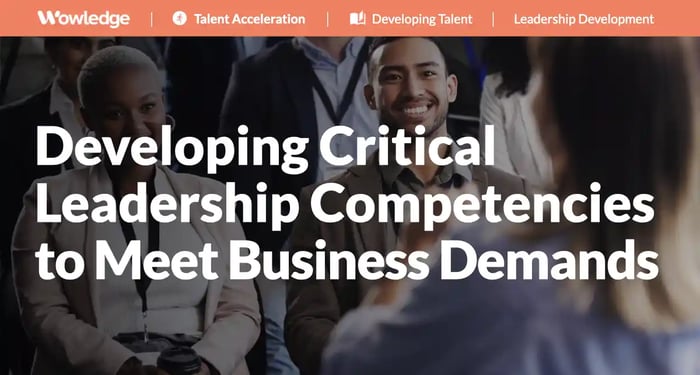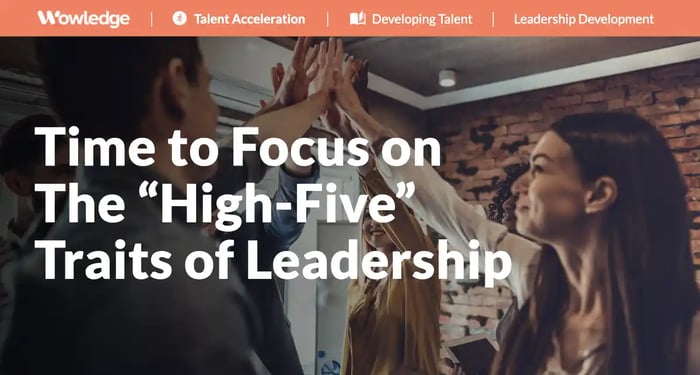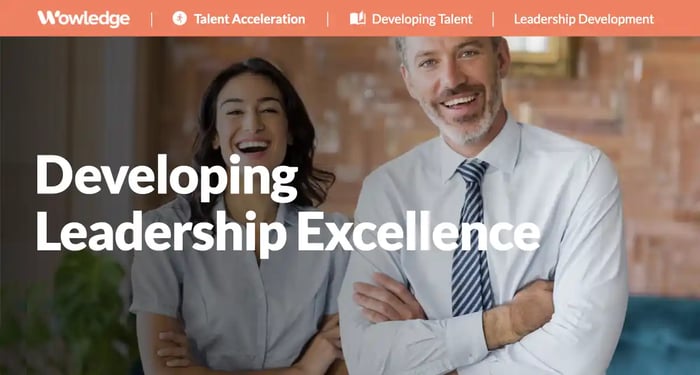Table of Contents
Leading organizations today is a high-stakes challenge that demands high-quality strategies and operational execution. The current environment is fraught with risks and challenges, including significant technological disruptions, labor market shortages, generational preference shifts, socio-political divisiveness, and climate hazards. These factors underscore the need for agility and responsiveness in leadership. The role of the leader remains unchanged, but the pressures of the current environment test those in the top roles. The need for understanding, developing, and maintaining critical leadership competencies —a combination of skills, knowledge, abilities, and behaviors— across the modern organization is not just a necessity but a continuous, never-ending process of learning and adaptation.
Several factors bring the need for such development to the forefront as a concern and competitive differentiator for organizations seeking to grow in the current environment. First, turnover in the executive ranks is increasing, with the average tenure of a C-suite executive down to only 4.9 years, a substantial decrease from only four years prior. And younger executives are found to be leaving at a faster rate. However, the most alarming statistic is the high failure rate, with Heidrick & Struggles reporting that 40% of senior-level leaders are forced out, fail, or quit within 18 months of hiring.
Poor assessment and selection may be the reasons for weak executive performance and fit, but the challenge appears to be bigger than improved candidate sourcing and assessment. Gallup reports that 82% of managers should not have been hired, and only 10% have the natural talent and necessary skills for leadership. However, another 20% have some of the required capabilities, and their gaps can be filled through development, highlighting the adaptability of leadership competencies and the significant potential for improvement.
Furthermore, managerial effectiveness appears to be at an all-time low. For example, one extensive survey found that 75% of employees reported that their managers were ineffective. Understanding and developing the critical leadership competencies that separate successful executives from the also-rans has never been more important than it is today.
The leadership development challenge
Building and sustaining a solid leadership team is a long-term strategy that requires adaptation to evolving business strategies, competitive and market environments, and circumstances. While data suggests that 86% of organizations provide leadership development programs, spending over $60 billion annually, only 10% of that spending delivers “concrete results.” The satisfaction with those programs is also low, with only 23% of leaders rating their leadership development as “high quality.”
The lack of satisfaction and low perceived impact may be due to the observation that leadership development programs are limited to the top levels, with data suggesting that only 5% of businesses offer leadership training at all levels. This denies earlier- and mid-career managers opportunities to be assessed and developed before they ascend to the highest levels of the organization. Making matters more complicated, only 57% of organizations assess leaders' and managers' strengths and skill or capability gaps, which can be used to more objectively determine their suitability and preparation needs for advancement into higher-level roles.
The problem with limiting assessment and development to the top tiers is reflected in the finding that only 11% of surveyed organizations stated that they had a “strong” or “very strong” leadership bench, the lowest percentage reported in years. Given the increasingly shortened C-suite tenures, a rash of Boomer and GenX retirements, and 40% executive failure rates, a lack of ready-now replacements represents an enormous barrier to sustainable enterprise success.
The leadership bench issue is real. The current leadership quality and a lack of a suitable pool of replacements plague organizations across the company size, industry, and geography spectrum. For example, only 28% of HR Leaders report that their companies have “high-quality leadership” (although 48% of their business leaders feel better about that). Other studies have found that 1/3 of CEOs think their organization’s frontline leadership quality is “very good” or “excellent,” and only 11% of HR leaders report that they have a solid bench from which to replace current leadership incumbents. Equally concerning is their statement that only 47% of strategically critical roles can be filled by current leaders.
The leadership development imperative
The impact of developing critical leadership competencies is substantial, even if it is not widely recognized or understood. Industry research has demonstrated this, starting with the finding that organizations with high leadership development maturity are eleven times (11X) more likely to have leaders capable of building talent for a competitive advantage and seven times (7X) more likely to inspire others to follow them. Even more important is the finding that company leadership development programs that effectively grow critical leadership competencies increase productivity by 36%, operational efficiency by 42%, and improve work output quality by an average of 48%. It further reports that those companies generate an average decrease in turnover of 77%.
Executive capabilities that can be developed have been shown to drive substantial returns on investment. For example, C-suite teams with high learning agility and social flexibility scores generated 25% higher profit margins than those companies whose C-suite lacked those capabilities. Similarly, McKinsey discovered that C-Suite teams with members who share a common set of growth-related mindsets and behaviors are well over twice (2.4X) more likely to outperform the competition.
These examples highlight the opportunity for significant enterprise achievements based on developing the right skills and mental models tailored and tuned to the organization's mission, culture, and business objectives.

Critical leadership competencies for development
Successful leaders bring a balance of strategic with operational, technical with humanistic, and internal with external awareness. They understand the trends in the marketplaces in which they operate, the technologies that can be leveraged to improve operations and outcomes, and the stakeholders that define their ecosystem. They need to be able to adapt and shift in anticipation of (or response to) changes in internal and external forces that support or stymie operational excellence and goal achievement. The critical leadership competencies for focus go beyond the typical competency model – they are aligned with the challenges leaders face every day, on the ground. From a variety of perspectives, research, and experience, these include:
Critical thinking
Related to quality decision-making, this has been found to be the most critical leadership skill in research. One study showed that it is the most essential skill to successfully lead an organization. It involves using evidence-based decision-making, where data and expert opinions are collected and considered, and fact-based conclusions are drawn that are relevant to the operating environment and needed outcomes. It shows up as a rational, highly analytical, and logical method of decision-making that is highly prized in organizations.
Adaptability and agility
These represent the ability to flex, quickly assess circumstantial and environmental changes, and change direction to take advantage of opportunities and avoid the negative consequences of staying put. A McKinsey study found that organizations with highly adaptive leaders are one and a half times (1.5X) more likely to outperform the competition. These skills include timely identifying new barriers to success, creating workarounds or alternative paths to that success, and effectively communicating and leading or facilitating the change.
Innovation
The ability to self-identify (or lead others to create) new ideas, concepts, approaches, workflows, products, and services that take advantage of previously unseen or emerging changes (internally or externally) is crucial in rapidly changing markets. A study by PWC found that 77% of CEOs view creativity as the most important leadership trait. Given the broad internet-driven access to new ideas, products, and services, the ability to generate innovative ideas, concepts, and methods can separate an organization from the competition.
Interpersonal management
Core to the success of a leader is the ability to develop and sustain constructive relationships with stakeholders, including bosses and boards, peers, subordinates, mentors and advisors, partners, suppliers, regulators, and community leaders. This has been shown to improve operational success, defect management, the quality of advice, input and feedback, and supplier and distributor reliability. Conflict management is a related and crucial skill, which the American Management Association reports takes up as much as 24% of a manager's time each week. Emotional Intelligence (EI) is also core to this. The awareness of and ability to manage one’s own perceptions and emotions while accurately seeking out and understanding those of others is a core element of great leaders. It supports developing and managing healthy interpersonal relationships and strong and vibrant cultures.
Data literacy and digital transformation management
With the increasing movement towards automation and digital tools for analysis, collaboration, ideation, and remote or hybrid work, proficiency and awareness of how to best leverage them are crucial. The LinkedIn Workplace Learning Report 2023 called this one of the highest-demand competencies, with a recent 30% increase in job posting requirements. Furthermore, the International Institute for Management Development (IMD), one of the top business schools in the world, reports that success in the current digital revolution is defined by people, not technology. While technical skills can be replaced by advanced technologies, a leader’s interactional, social, strategic, and conceptual competencies are the difference maker. It is essential to understand how to leverage AI and machine learning technologies, communicate their use and importance to employees, balance skills replacement while maintaining jobs, and address issues around data security and the ethical use of that data.
Cross-cultural competence
The world's populations and business ecosystems continue to evolve, with increasingly changing birth rates, immigration, and cross-border commerce patterns. Multinational relationships are more critical than ever, with globally dispersed supply chains and changing socio-political forces driving changes in favored country statuses. The critical leadership competencies for understanding and operating in such environments include cultural, language, and legal/regulatory expertise. Changing labor markets also drive the need for more awareness and cultural competence around employee and contractor (onshore and offshore) styles, preferences, and expectations.

Upgrading leadership development
Building better programming for developing critical leadership competencies involves more than selecting an external provider to design and deliver a signature program. It requires a comprehensive strategy that defines a clear purpose and objectives, is aligned with the business, is multi-modal, addresses current and future leaders' learning styles and preferences, and has a traceable impact through robust measurement. The critical phases of development include:
1. Link strategic business requirements to critical leadership competencies for development
Review business strategy documents (or interview top and key functional executives) to identify critical operational, financial, market, and development goals from which associated leadership capabilities can be discerned. Identify the critical business (e.g., customer focus, revenue growth, operational efficiency) and talent (employee experience, engagement, critical role retention) drivers of value associated with achieving those goals. Determine the associated leadership competencies —skills, knowledge, abilities, and behaviors— that will support and optimize the execution of those drivers.
2. Establish a strategy
Set out the purpose and objectives of the program/process to develop critical leadership competencies. Be clear about the reason, desired outcomes of attendance, and the program's targeted audience. Be prepared to list the job roles and levels to be developed and articulate a purpose and intended capability outcomes. For example, top leaders should be able to effectively manage goals and address challenges related to and aligned with the strategic plan. Middle managers should be trained and provided with experiences to hire, develop, and manage workers more effectively in ways that meet company operational, financial, and customer requirements. Create plans aligned with different levels and groups of managers and leaders, as well as delivery schedules, budgets, and resource requirements.
3. Develop leaders at all levels
While prioritizing the development of incumbent executives addresses the here-and-now, building skills of high potentials (HiPos) and middle managers over time brings greater returns by developing a robust pool of future leadership candidates. Given the finding by Gallup that only 30% of managers have some to all the necessary qualities and capabilities to meet the requirements of leadership positions, the opportunity to train, observe, develop, and monitor their development of critical leadership competencies is a must. The ability to develop all-around leaders who have demonstrated their ability to learn and grow technically as managers of people, processes, and products and as reliable stewards of the organization's culture is embedded in early identification and ongoing assessment practices. Research has demonstrated the value of this with internally hired leaders being successful 65% of the time versus 52% of external leadership hires.
4. Create responsive programming
Develop or acquire content that addresses the vision and future leadership needs and engages participants in group, self-paced, or experiential learning. Use employee listening methods to understand the targeted participants' content delivery preferences and needs. For example, research suggests that 48% of leaders prefer executive coaching, 42% prefer developmental assignments, 42% prefer skill gap assessments, and 39% prefer formal training programs. Create a blend of learning delivery options that can be efficiently packaged (or unpackaged) based on the ideal delivery mechanism for each piece of content or learning “chunk.” Develop signature programs and group learning or coaching cohorts that bring participants together and eLearning, books, articles, podcasts, videos, and simulations for self-paced learning.
Consider AI-based development recommendations linked to individual development needs and plans, gamified content that motivates continuous learning, job rotations and mobility, and experiential opportunities such as coaching and mentoring that provide opportunities for practice and feedback. Integrate job rotations (including leadership-to-individual contributor roles) to control burnout and broaden specialized skills. Use cross-functional projects that enable leaders to learn and practice team problem-solving while broadening their internal networks to better appreciate workflow partners, increasing connections for future collaboration, support, and innovation, and learning new work methods.
5. Leverage formal leadership assessments and analyses
Use structured (and validated) assessments to identify strengths and gaps in advancement potential and readiness, leadership style, corporate leadership competency and skill levels, emotional intelligence, decision-making, personality, and other related capabilities. Integrate these findings into individual development plans (IDPs) and mobility decision-making. Use succession (and performance) management processes to evaluate leadership incumbents and candidates through talent and performance reviews by focusing on results achieved, exhibition of leadership competencies, and feedback from other leaders and (ideally) subordinates. Use employee engagement and pulse and 360-degree or upward feedback surveys to generate a more comprehensive understanding of development opportunities. Integrate these findings into hiring, promotion, development, and succession decisions. Research has shown that companies that used high-quality assessments experienced a 30% improvement in bench strength.
6. Engage top leaders
Get top leaders involved in overseeing and managing the development of leaders and managers below them. Create governance councils that supervise the leadership development process, content, delivery mechanisms, budgets and expenditures, and measurable talent and business outcomes. Hold them accountable for developing and championing their subordinate management teams’ development and growth. Engage them as mentors, training segment leaders, group coaching facilitators, and lessons-learned storytellers.
7. Make it continuous
Create an expectation and culture around continuous development for all leaders. Resist the urge to over-rely on signature programs and formal learning. Make IDP creation and monitoring an annual requirement for specific competencies or experiences that round out the leader. Consider peer-based development cohort groups for those with mutual skill needs, such as those for advanced people management and coaching skills, business acumen, or customer focus. Create a culture around shared books, TED Talks, and thought-provoking articles from prominent business schools, professional journals, and consultancies.
8. Measure it
Evaluation of talent and business process efficiency and outcome effectiveness are essential to the longevity and sustainability of a leadership development program. Identify KPIs and create dashboards that allow progress and success to be monitored. Focus on behavior changes and improvements, including the frequency and consistency of constructive leadership behavior, strategic business decisions and actions, and people, processes, products, and customer outcomes. Consider also the development program process metrics related to participant levels, content use (e.g., hits, % read, return visits), completions, and social and sharing metrics.
Relevant Practices & Tools
Advanced Leadership Development Practices to Drive the Business, Identify and Build Leaders Across Levels. >
Leadership Development (LD) is a business strategy-aligned approach structured around an idealized vision of how leaders will conduct themselves and the business... more »
Leveraging Formal Assessments to Reliably Identify Development Goals. >
Formal assessments bring heightened objectivity to leadership development efforts, reducing bias from purely opinion- and observation-based assessments of strengths, fit and competencies... more »
Developing Leaders Across Multiple Levels of Management. >
Advanced leadership development is designed to not only develop current executives, but "leaders" in all levels of the organization... more »
Defining Leadership Competencies that Provide Consistent Benchmarks. >
The initial step is to define what will ultimately be the target for leaders' development. Competencies are clusters of job skills and behaviors that contribute to job success... more »
The Business Strategy to Leadership Needs Conversion Template: Capture Insights to Convert Strategies into Development Requirements. >
A tool to identify the leadership competencies, skills and capabilities from key business objectives articulated in either formal strategic plans or by top functional business leaders... more »
About Wowledge
Wowledge is the expert-driven platform for lean teams building strategic HR programs. Members enjoy access to up-to-date best practices, step-by-step guides, tools, templates, and insights to accelerate the design and implementation of all key HR programs and processes.
Since each organization has unique characteristics, needs, and aspirations, Wowledge's practices are developed utilizing an exclusive stage-based approach – from Core to Advanced to Emerging – that reflects distinct levels of sophistication to meet our members where they are.
Build strategic HR programs with refreshingly easy-to-follow best practices.
Get started for FREE! Learn more.










